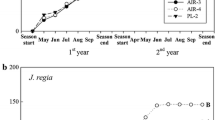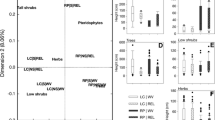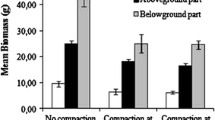Abstract
Despite several studies demonstrating that deep planting has no negative effects on seedling development, conifer seedlings are still typically planted to depths of 3–5 cm in boreal forests. Planting machines plant seedlings deeper. While machine planting has become more common in boreal forests, there is still a need to demonstrate that conifer seedlings can be planted using this method without reduced field performance of seedlings. To investigate the effects of deep planting on Norway spruce (Picea abies (L.) Karst.) container seedlings, we established two experiments in Central Finland in 2006 and 2009. In the experiment on a site with medium coarse soil, planting depths were 0, 2, 5 and 8 cm. In the experiment established on fine-textured soil, planting depths were 3, 6 and 10 cm. During the first 4 years after planting, deeper planted seedlings grew better and at the end of the fourth season initial differences in shoot length among planting depths had disappeared. Incidence of insect damage was relatively low, and no differences among planting depths were found. During the dry summer, there was a positive relationship between increased planting depth and improved survivability of seedlings. In conclusion, deep planting improved growth of Norway spruce seedlings and was an advantage in dry conditions.



Similar content being viewed by others
References
Bergsten U, Goulet F, Lundmark T, Ottoson Löfvenius A (2001) Frost heaving in a boreal soil in relation to soil scarification and snow cover. Can J For Res 31:1084–1092
Beyeler J (1996) Effect of planting methods on field performance of black spruce five years after planting. For Res Rep 62:1–16
Björklund N, Nordlander G, Bylund H (2003) Host-plant acceptance on mineral soil and humus by the pine weevil Hylobius abietis (L.). Agric For Entomol 5:61–65
Bréda N, Huc R, Granier A, Dreyer E (2006) Temperate forest trees and stands under severe drought: a review of ecophysiological responses, adaptation processes and long-term consequences. Ann For Sci 63:625–644
Buitrago M, Paquette A, Thiffault N, Bélanger N, Messier C (2015) Early performance of planted hybrid larch: effects of mechanical site preparation and planting depth. New For 46:319–337. doi:10.10007/s11056-014-9463-3
Cajander AK (1949) Forest types and their significance. Acta For Fenn 46:1–71
de Chantal M, Rita H, Bergsten U, Ottoson Löfvenius M, Grip H (2006) Effect of soil properties and soil disturbance on frost heaving of mineral soil: a laboratory experiment. Can J For Res 36:2885–2893
Ersson BT, Jundén T, Bergsten U, Servin M (2013) Simulated productivity of one- and two-armed tree planting machines. Silva Fenn 47(2). http://www.silvafennica.fi/article/958
Freij J, Örlander G (1987) Högläggning på mineraljord eller humustäcke—en försöksserie med olika trädslag, planttyper och planteringstidpunkter. [Mounding in mineral soil or humus—an experimental series for different tree species, seedling types and planting dates] Institutionen för skogskötsel, SLU, Arbetsrapporter 19 (in Swedish)
Gemmel P, Nilsson U, Welander T (1996) Development of oak and beech seedlings planted under varying shelterwood densities and with different site preparation methods in southern Sweden. New For 12:141–161
Grossnickle SC (2000) Ecophysiology of northern spruce species: the performance of planted seedlings. NRC Research Press, Ottawa
Heiskanen J, Saksa T, Luoranen J (2013) Soil preparation method affects outplanting success of Norway spruce container seedlings on till soils susceptible to frost heave. Silva Fenn 47(1). http://www.silvafennica.fi/article/893
Keane M (2006) Container plants and mechanized planting—the way forward? In: MacLennan L, Fennessy J (eds) Plant quality, A key success in forest establishment. In: Proceedings of the COFORD conference, 20–21 September 2005, Mount Wolseley Hotel, Tullow, Co Carlow. COFORD, Dublin, pp 67–71
Krasowski MJ, Elder RJF (2000) Opportunities for improvements to reforestation success. British Columbia, Ministry of Forest Research Program, Extension note 43
Lähde E, Mutka K (1974) Luontaisesti syntyneiden ja istutettujen kuusentaimien kehitys ja juuriston rakenne Pohjois-Suomessa. [The structure of the root system and development of volunteer and planted Norway spruce transplants in Northern Finland]. Comm Inst For Fenn 83:1–53 (in Finnish with English summary)
Laine T, Kärhä K, Hynönen A (2016) A survey of the Finnish mechanized tree-planting industry in 2013 and its success factors. Silva Fenn. doi:10.14214/sf.1323
Landis TD, Dumroese RK, Haase DL (2010) The container tree nursery manual, vol 7, Seedling processing, storage, and outplanting. Agric. Handbk. 674. Department of Agriculture Forest Service, Washington
Långström B (1982) Abundance and seasonal activity of adult Hylobius-weevils in reforestation areas during first years following final felling. Comm Inst For Fenn 106:1–23
Lindelöw Å (1992) Seedling mortality caused by Hylastes cunicularius Er. (Coleoptera, Scolytidae) in Picea abies plantations in Northern Sweden. Scand J For Res 7:387–392
Luoranen J, Viiri H, Ylioja T (2009) Marshall SusCon CR—valmisteen teho tukkimiehentäitä ja juuriniluria vastaan. [Effectiveness of Marshall SusCon CR against pine weevil and black spruce beetle] Taimiuutiset 3/2009:19–21 (in Finnish)
Luoranen J, Rikala R, Smolander H (2011) Machine planting of Norway spruce by Bracke and Ecoplanter: an evaluation of soil preparation, planting method and seedling performance. Silva Fenn 45:341–357. http://www.metla.fi/silvafennica/full/sf45/sf453341.pdf
Macadam A, Bedford L (1998) Mounding in the sub-boreal spruce zone of west-central British Columbia: 8-year results. For Chron 74:421–427
Nilsson U, Örlander G (1995) Effects of regeneration methods on drought damage to newly planted Norway spruce seedlings. Can J For Res 25:790–802
Nordlander G, Örlander G, Langvall O (2003) Feeding by the pine weevil Hylobius abietis in relation to sun exposure and distance to forest edges. Agric For Entom 5:191–198
Nordlander G, Bylund H, Björklund N (2005) Soil type and microtopography influencing feeding above and below ground by the pine weevil Hylobius abietis. Agric For Entom 7:107–113
Oliet JA, Artero F, Cuadros S, Puértolas J, Luna L, Grau JM (2012) Deep planting with shelters improves performance of different stocktype sizes under arid Mediterranean conditions. New Forest 43:925–939. doi:10.1007/s11056-012-9345-5
Örlander G (1986) Effect of planting and scarification on the water relations in planted seedlings of Scots pine. Studia For Suec 173:1–17
Örlander G, Gemmel P, Wilhelmsson C (1991) Effects of scarification, planting depth and planting spot on seedling establishment in a low humidity area in southern Sweden. Swedish University of Agricultural Sciences, Department of Silviculture. Report 33 (in Swedish with English summary)
Paquette A, Girard A-P, Walsh D (2011) Deep planting has no short- or long-term effect on the survival and growth of white spruce, black spruce, and Jack pine. North J Appl For 28:146–151
Petersson M, Örlander G (2003) Effectiveness of combinations of shelterwood, scarification, and feeding barriers to reduce pine weevil damage. Can J For Res 33:64–74
Petersson M, Örlander G, Nordlander G (2005) Soil feature affecting damage to conifer seedlings by the pine weevil Hylobius abietis. Forestry 78:83–92. doi:10.1093/forestry/cpi008
Sahlén K, Goulet F (2002) Reduction of frost heaving of Norway spruce and Scots pine seedlings by planting in mounds or in humus. New For 24:175–182
Schwan T (1994) Planting depth and its influence on survival and growth. Literature review with emphasis on Jack pine, black spruce and white spruce. Ontario Ministry of Natural Resources, Northeast Science & Technology, Technical report TR-017
Söderström V, Bäcke J, Byfalk R, Jonsson C (1978) Jämforelse mellan plantering i jordrabatter och efter andra markberedningsmetoder. [Comparison between planting in mineral soil heaps and after other soil treatment methods]. Rapporter och uppsatser 11 (in Swedish with English abstract)
Sutton RF (1967) Influence of planting depth on early growth of conifers. Commonw For Rev 46:282–295
Sutton RF (1995) Advantages of deep planting black spruce. Technical note 50. Canadian Forest Service, Ontario
Tarroux E, DesRochers A, Girard J-P (2014) Growth and root development of black and white spruce planted after deep planting. For Ecol Manag 318:294–303. doi:10.1016/j.foreco.2014.01.032
Thorsén Å, Mattson S, Weslien J (2001) Influence of stem diameter on the survival and growth of containerized Norway spruce seedlings attacked by pine weevils (Hylobius abietis). Scand J For Res 16:54–66
Valkonen S (2005) Metsänuudistaminen [Forest regeneration]. In: Rantala S. Metsäkoulu. Metsäkustannus Oy, pp 55–80 (in Finnish)
Venäläinen A, Tuomenvirta H, Drebs A (2005) A basic Finnish climate data set 1961–2000—description and illustrations. Finnish Meteorological Institute. Reports 2005:5
Whaley RE, Niznowski G, Buse LJ (1995) The effect of deep planting black spruce: fifth-year field results. In: Ontario Ministry of Natural Resources, Northwest Science & Technology, Thunder Bay, Ontario. Technical report TR-92
Acknowledgments
The research was conducted in co-operation with UPM-Kymmene Corporation who carried out soil preparation in both study areas. We thank Arvi Jääskeläinen and Martti Udd for planting the seedlings, Mervi Ahonpää, Auli Lehtinen, Mikko Tikkinen and Pekka Voipio for the seedling measurements and Dr. Heikki Smolander and three anonymous referee for valuable comments to the manuscript. The language was checked by Semantix. The study was solely financed by the Finnish Forest Research Institute through projects 3450 and 3554.
Author information
Authors and Affiliations
Corresponding author
Rights and permissions
About this article
Cite this article
Luoranen, J., Viiri, H. Deep planting decreases risk of drought damage and increases growth of Norway spruce container seedlings. New Forests 47, 701–714 (2016). https://doi.org/10.1007/s11056-016-9539-3
Received:
Accepted:
Published:
Issue Date:
DOI: https://doi.org/10.1007/s11056-016-9539-3




